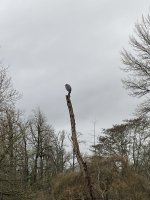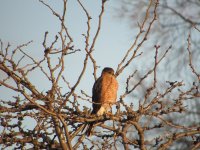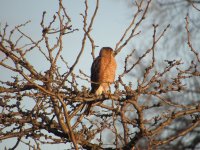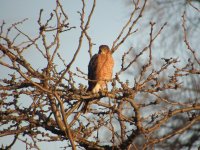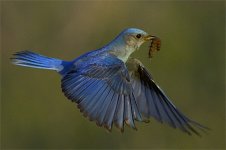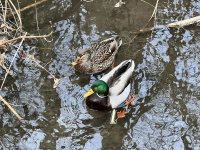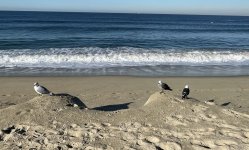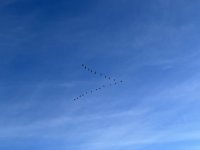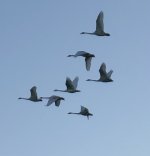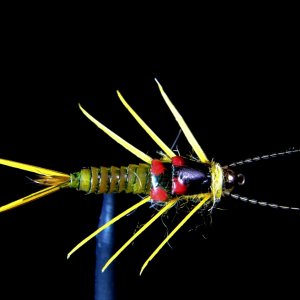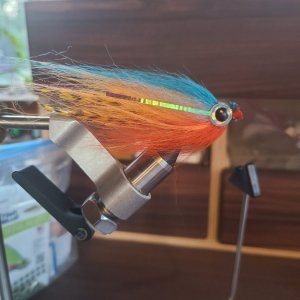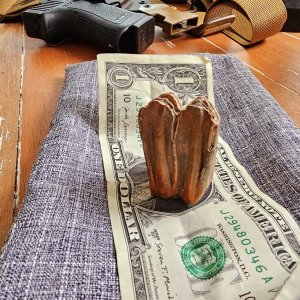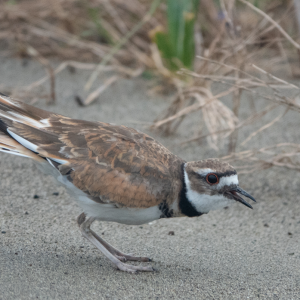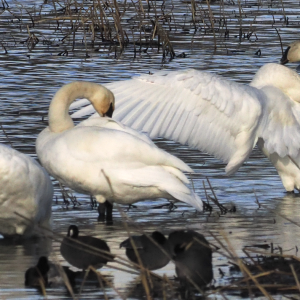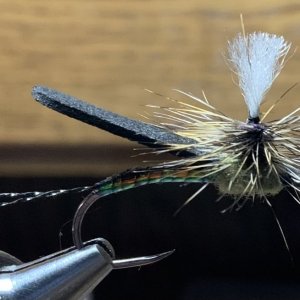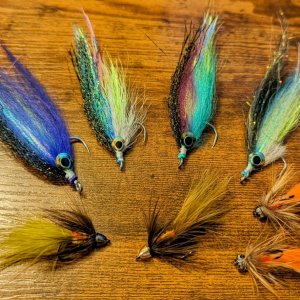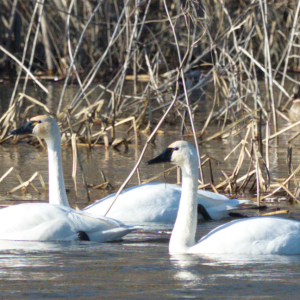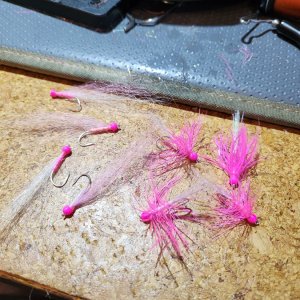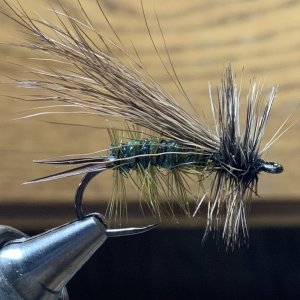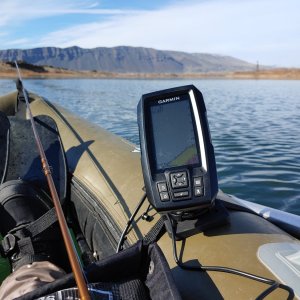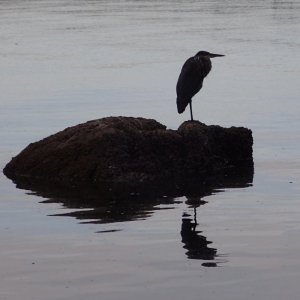You are using an out of date browser. It may not display this or other websites correctly.
You should upgrade or use an alternative browser.
You should upgrade or use an alternative browser.
Got any bird pics?
- Thread starter Wadin' Boot
- Start date
I agree with your ID (and with the difficulty). Great light!!!A Cooper's hawk I believe. I struggle to tell them and Sharp-shinned apart.
View attachment 98414View attachment 98415View attachment 98414
Steve
My wife and I spent the holidays house-sitting for friends on San Juan Island (tough work, but we persevered in spite of the hardships). We know this island so well (we thought, more in a later post…) and we headed out every decent day to look for wildlife. In the end, we identified 67 bird species and seven mammals in 10 days - not bad.
One of the striking species that we saw frequently were harlequin ducks (2nd cutest in NA after woodies). On our first excursion, we encountered a small group of harlequins at Limekiln Lighthouse on the West Side of San Juan. The group included a drake in peak breeding plumage with blue speculum feathers and brick-red side patch,
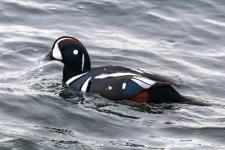
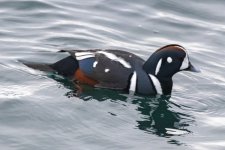
a drake transitioning from its slightly less-gaudy winter plumage (note brown back),
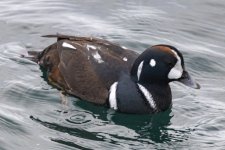
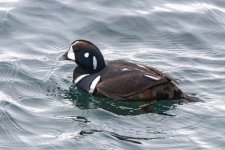
and a more subdued hen.
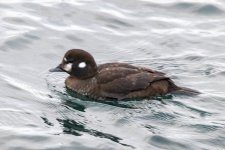
Like most feathered wildlife in the San Juans during hunting season, the harlequins were quite spooky, but I managed to play “hide-and-seek” with the flock around the lighthouse. They were diving just off the intertidal rocks. While the scientific literature indicates that they feed on aquatic insects, especially caddis larvae, while in the upper stretches of fast mountain streams, these birds were clearly harvesting algae from the shallow subtidal and intertidal.
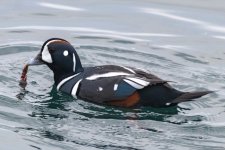
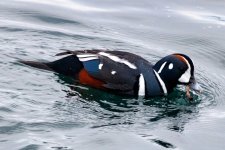
Steve
One of the striking species that we saw frequently were harlequin ducks (2nd cutest in NA after woodies). On our first excursion, we encountered a small group of harlequins at Limekiln Lighthouse on the West Side of San Juan. The group included a drake in peak breeding plumage with blue speculum feathers and brick-red side patch,


a drake transitioning from its slightly less-gaudy winter plumage (note brown back),


and a more subdued hen.

Like most feathered wildlife in the San Juans during hunting season, the harlequins were quite spooky, but I managed to play “hide-and-seek” with the flock around the lighthouse. They were diving just off the intertidal rocks. While the scientific literature indicates that they feed on aquatic insects, especially caddis larvae, while in the upper stretches of fast mountain streams, these birds were clearly harvesting algae from the shallow subtidal and intertidal.


Steve
RCF
Life of the Party
This thread is the best thread on this site as well as many other sites. I have learned more everyday from posts here than I learned from weeks or months reading others.
To see birds I have never seen or knew about and in our backyard is awe inspiring. To see birds in their native habitat only makes it better.
Thank you from the bottom of my heart for spending time helping others, including me, and sharing with us.
To see birds I have never seen or knew about and in our backyard is awe inspiring. To see birds in their native habitat only makes it better.
Thank you from the bottom of my heart for spending time helping others, including me, and sharing with us.
Gyrfalcon22
Life of the Party
@Cabezon really brings the goods !This thread is the best thread on this site as well as many other sites. I have learned more everyday from posts here than I learned from weeks or months reading others.
To see birds I have never seen or knew about and in our backyard is awe inspiring. To see birds in their native habitat only makes it better.
Thank you from the bottom of my heart for spending time helping others, including me, and sharing with us.
Rare 2024 January sun today provided a chance for one of the local red-tails to show off its beautiful contrasting plumage.
Last edited:
Jim F.
Still a Genuine Montana Fossil
Outstanding! An opportunity to photograph 1 of those could almost get me to drive over to the coast. Looks like God designed Wood Ducks and Picasso designed the Harlequin . . .harlequin ducks (2nd cutest in NA after woodies
Yes he does, just as you do, John! Thank you both for sharing some amazing photos!@Cabezon really brings the goods !
Gyrfalcon22
Life of the Party
Jim, I fully agree with your assessment of @Cabezon Harlequins and addition of Wood Duck vying for the title of coolest duck. Otherworldly design work !
A couple more from yesterday. Only lens I carry is usually one big prime + phone. When a rainbow happens the 1200mm lens perspective (600mm on a m4/3 body=24x) is too tight to even get all the colors in.
And below: the golden eagle showed briefly for semi-far views. He sure looks raggedy when it rains. Makes me suspect there is great reason they are not normally lowland Wetside birds. I see some scruffy looking bald eagles but they clean up fast. The golden eagle is kind of a Pig-Pen type.
Add one a tad older from this year. Pintail with a wigeon taking a quick peek to make sure they are on the right end of a hunting immature bald eagle
A couple more from yesterday. Only lens I carry is usually one big prime + phone. When a rainbow happens the 1200mm lens perspective (600mm on a m4/3 body=24x) is too tight to even get all the colors in.
And below: the golden eagle showed briefly for semi-far views. He sure looks raggedy when it rains. Makes me suspect there is great reason they are not normally lowland Wetside birds. I see some scruffy looking bald eagles but they clean up fast. The golden eagle is kind of a Pig-Pen type.
Add one a tad older from this year. Pintail with a wigeon taking a quick peek to make sure they are on the right end of a hunting immature bald eagle
Last edited:
In keeping with the waterfowl theme, here's a nice drake cinnamon teal which I photographed along the California/Oregon border a few years ago. Cinnamon teal are true neotropical migrants, nesting throughout the western US and wintering primarily in Mexico and Central America. This beautiful little puddle duck rarely shows up in the waterfowl hunter harvest due to the fact that they are usually gone by the time hunting season opens.
We had a decent breeding population of cinnamon teal on CADFW lands in Northern California. For many years, our staff trapped and banded local breeding ducks as part of a flyway wide program to monitor waterfowl populations. As I recall, most of our cinnamon teal band recoveries were from the esteros along the west coast of Mexico. Their bill morphology is similar to a shoveler.
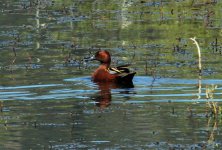
We had a decent breeding population of cinnamon teal on CADFW lands in Northern California. For many years, our staff trapped and banded local breeding ducks as part of a flyway wide program to monitor waterfowl populations. As I recall, most of our cinnamon teal band recoveries were from the esteros along the west coast of Mexico. Their bill morphology is similar to a shoveler.

Last edited:
Bass-O-Matic
Life of the Party
In our holiday excursion around San Juan Island, we know where to expect to see specific species, especially favorites like bald eagles and American kestrels. For example, we commonly find an American kestrel perched on telephone wires or at the top of shrubs near False Bay and Bailer Hill Road.
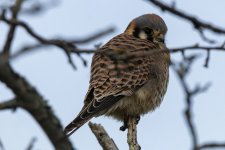
And for many years, there has been a pair of bald eagles who perch on bare branches just below the crown of a tall Douglas fir opposite the DNR site that overlooks Goose Island. I had been concerned that the construction of two new houses near the Douglas fir might disturb the eagles, but the pair were perched undisturbed even as workers were performing low-key finish work on one of the houses underneath their perch.
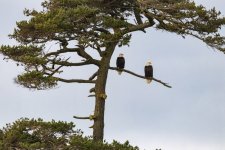
Hopefully, everyone can co-exist. Another pair of bald eagles covers Deadman Bay and Limekiln State Park.
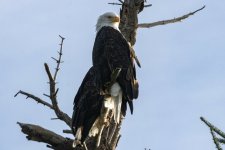
During one afternoon visit to Limekiln, we observed one of these birds flying low over the water from Haro Strait with what appeared to be a dead seabird in its talons. It was followed by a gull that might have been looking for scraps (or trying, in vain, to rescue a family member).
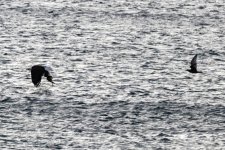
The bald eagle landed on a rocky ledge near Deadman Bay for its meal.
Steve

And for many years, there has been a pair of bald eagles who perch on bare branches just below the crown of a tall Douglas fir opposite the DNR site that overlooks Goose Island. I had been concerned that the construction of two new houses near the Douglas fir might disturb the eagles, but the pair were perched undisturbed even as workers were performing low-key finish work on one of the houses underneath their perch.

Hopefully, everyone can co-exist. Another pair of bald eagles covers Deadman Bay and Limekiln State Park.

During one afternoon visit to Limekiln, we observed one of these birds flying low over the water from Haro Strait with what appeared to be a dead seabird in its talons. It was followed by a gull that might have been looking for scraps (or trying, in vain, to rescue a family member).

The bald eagle landed on a rocky ledge near Deadman Bay for its meal.
Steve
On New Year’s Day, we were doing our normal loop of wildlife locations on San Juan Island: Jackson Beach / Argyll Lagoon, DNR site overlooking Goose Island, Cattle Point Lighthouse, etc. We stopped briefly in the parking area by Robert’s Redoubt (the same Robert who later wrote “Robert’s Rules of Order”) at American Camp National Historic Monument to discuss where to go next. Through the window, I noted an atypical flying behavior off in the distance over the top of the redoubt. My initial thought was that this might be a Northern harrier (and it may well have been). As we hadn’t seen a Northern harrier this trip, we decided to climb to the top of the redoubt for a better view. Great decision.
We reached the top of the redoubt and scanned down toward the ocean over the grasslands and shrubs. At the moment, there were no birds flying in our field of view. But this isn’t unusual as Northern harriers will often rest on the ground or low-lying shrubs between foraging sites. I noted a suspicious lump on the ground in the view of my binocs, but this lump wasn’t a Northern harrier, but instead it was a short-eared owl!!! This bird and other owls (and real Northern harriers) began their distinctive low flights over the grasses and shrubs in their search for voles. At one point, we counted three short-eared owls and a Northern harrier covering the same area (and chasing each other off) in this field between the rabbit warrens and the houses at Eagle Cove.
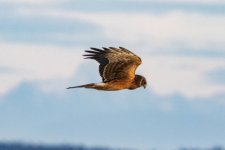
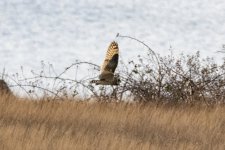
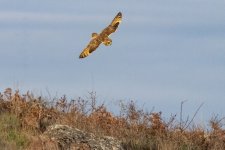
To our left at the western edge of the warren, there was another short-eared owl and another Northern harrier male. We hiked down from the heights of the redoubt along trails that lead across the middle of the field to South Beach and other locations in the hope that the owls and harriers might pass close by. We could see that the birds were not impacted by other people (even with leashed dogs) who were walking along the network of trails that lead from the redoubt toward the western end of South Beach. But alas, the birds never did approach as close as I would like (but soon – previews of coming attractions); still we were delighted with our good views.
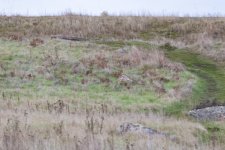
Steve
We reached the top of the redoubt and scanned down toward the ocean over the grasslands and shrubs. At the moment, there were no birds flying in our field of view. But this isn’t unusual as Northern harriers will often rest on the ground or low-lying shrubs between foraging sites. I noted a suspicious lump on the ground in the view of my binocs, but this lump wasn’t a Northern harrier, but instead it was a short-eared owl!!! This bird and other owls (and real Northern harriers) began their distinctive low flights over the grasses and shrubs in their search for voles. At one point, we counted three short-eared owls and a Northern harrier covering the same area (and chasing each other off) in this field between the rabbit warrens and the houses at Eagle Cove.



To our left at the western edge of the warren, there was another short-eared owl and another Northern harrier male. We hiked down from the heights of the redoubt along trails that lead across the middle of the field to South Beach and other locations in the hope that the owls and harriers might pass close by. We could see that the birds were not impacted by other people (even with leashed dogs) who were walking along the network of trails that lead from the redoubt toward the western end of South Beach. But alas, the birds never did approach as close as I would like (but soon – previews of coming attractions); still we were delighted with our good views.

Steve
Cabezon - great as usual!
Just a reminder, bring your hummer feeders in, keep them fed. Our hummers have been busy. Also, for those not in the know, don’t waste money on the red colored mix. Hummers are attracted to the feeder colors. One part sugar, four parts water, heat a bit to help dissolve the sugar. Keep those hummers that stay around happy. Some tend to stay through the winter because of the feeders.
Thanks
Just a reminder, bring your hummer feeders in, keep them fed. Our hummers have been busy. Also, for those not in the know, don’t waste money on the red colored mix. Hummers are attracted to the feeder colors. One part sugar, four parts water, heat a bit to help dissolve the sugar. Keep those hummers that stay around happy. Some tend to stay through the winter because of the feeders.
Thanks
Great advice!Cabezon - great as usual!
Just a reminder, bring your hummer feeders in, keep them fed. Our hummers have been busy. Also, for those not in the know, don’t waste money on the red colored mix. Hummers are attracted to the feeder colors. One part sugar, four parts water, heat a bit to help dissolve the sugar. Keep those hummers that stay around happy. Some tend to stay through the winter because of the feeders.
Thanks
And those feeders with thawed/liquid nectar need to be put out earlier than many think, earlier than daybreak… it’s surprising that they’ll make their first visit very early in the morning, just before daylight.
It would be a shame to have them show up to frozen nectar. that could be their last flight.
I had to thaw the feeders several times during the day today , they otherwise would freeze solid.
On our way home from San Juan Island after New Year’s Day, my wife and I decided to stop by the Samish Flats to look for more short-eared owls. When we first arrived, all was quiet, nobody flying but some swans coming in the join a larger flock off in the distance. But shortly after 1:15, we spotted a Northern harrier flying off in the distance in the field to our right (east of the road).
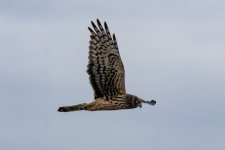
Shortly afterward, the first short-eared owl appeared followed by a second. Per usual, they turned aggressive if the Northern harrier wandered too close to them. None of these birds flying around the right (east) field were approaching very close to the road; they were content to forage in the middle of a large field.
Two other short-eared owls popped up in the left-hand field (west of the road). One of these birds was focused on a section close by the road. There were already 10 photographers lined up along the verge of the road and snapping pictures at a frantic pace when I joined the throng. This bird was totally unperturbed by our presence (and the burst shooting of the “owlarazzi” perhaps 50’ away). It continually returned to a favored perch, a bent-over stem of a thick weed that stood perhaps 6-10” above the other vegetation or to the ground nearby.
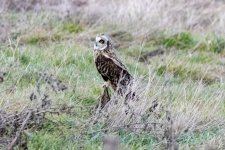
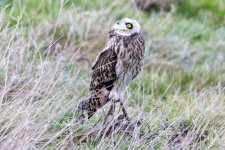
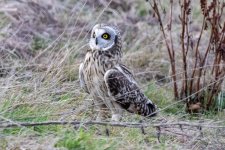
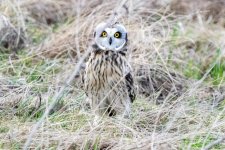
It would scan left, center, right, and even directly up. Periodically, it would launch itself into the air, loop around this eastern edge of the field, drop on likely targets, drive off any other short-eared owl that approached too close, and then then return to perch on the same stem.
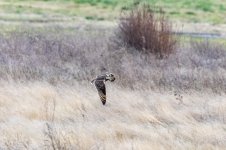
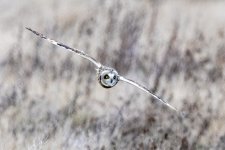
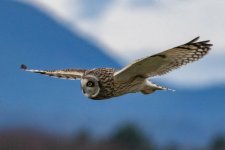
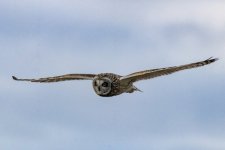
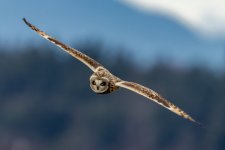 Steve
Steve

Shortly afterward, the first short-eared owl appeared followed by a second. Per usual, they turned aggressive if the Northern harrier wandered too close to them. None of these birds flying around the right (east) field were approaching very close to the road; they were content to forage in the middle of a large field.
Two other short-eared owls popped up in the left-hand field (west of the road). One of these birds was focused on a section close by the road. There were already 10 photographers lined up along the verge of the road and snapping pictures at a frantic pace when I joined the throng. This bird was totally unperturbed by our presence (and the burst shooting of the “owlarazzi” perhaps 50’ away). It continually returned to a favored perch, a bent-over stem of a thick weed that stood perhaps 6-10” above the other vegetation or to the ground nearby.




It would scan left, center, right, and even directly up. Periodically, it would launch itself into the air, loop around this eastern edge of the field, drop on likely targets, drive off any other short-eared owl that approached too close, and then then return to perch on the same stem.




 Steve
Steve
